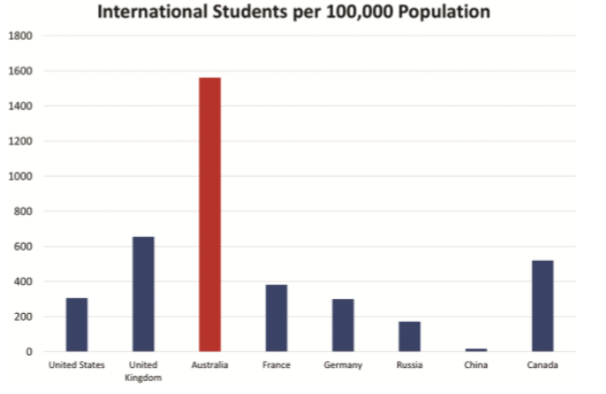Denis Blight – former CEO of international education placement organisation, IDP Education Limited, and a visitor in the History Department of the Australian National University – has penned a self-serving article in The Australian calling for policy makers to “increase and sustain” international student enrolments.
The main arguments of the article are as follows:
- International students feel abandoned by Australian and many are considering alternate study destinations.
- Australia’s education ‘exports’ had grown rapidly since 2000 but are now at risk.
- Many students are motivated to study in Australia to obtain permanent residency. “If we recognise this motivation as legitimate, we need to promote an equally transparent international student path to permanent residence and citizenship lest we are outpaced by the UK and Canada”.
- “Our aim must be to increase and sustain international enrolments in Australian universities and colleges”. Because education is supposedly a major export and foreign students supposedly enrich university life.
- We also must “sustain Australian community support and taxpayer funding for the international education program”.
- The government must build “a uniquely Australian edge by providing pathways for international students to employability and residency”.
- The government “should accord higher education the status of any big, successful export sector” and “show the colour of its money”.
I have never read such self-serving bullshit in my life. Not once in the article does Denis Blight mention any of the costs associated with our universities’ extreme concentration on international students, which before COVID was was roughly 2.5 times the United Kingdom’s, three times Canada’s, and six times the United States’:
These broader costs include:
- Erosion of entry and teaching standards at universities, as documented in 2019’s Four Corners report and elsewhere.
- Negative impacts on the labour market given students are allowed to work. These students are vulnerable and tend to come here with little money. They are ground zero for wage underpayment and theft, and contribute to Australia’s chronically poor wages growth. They are a key component of Australia’s broader immigration story.
- Erosion of freedom of speech: as witnessed at UQ with the Drew Pavlou affair. We’ve got 13 CCP-run Confucius Institutes operating at Australia’s universities.
The claimed ‘export’ benefits of international education are also wildly exaggerated.
The majority of education ‘exports’ come in the form of expenditure on goods and services in Australia, as explicitly acknowledged recently by the Mitchell Institute:
The majority of the $20 billion loss of economic value is in the form of goods and services spent in the broader economy: about 36% on accommodation and another 36% is on hospitality and retail.
Given that most international students fund a significant proportion of their expenses via income earned while working in Australia, this by definition is not an export.
The fact that so many international students fell into hardship when they lost their jobs at the beginning of the pandemic, and then demanded taxpayer support, also highlights this point. As does the fact that youth unemployment has fallen sharply despite rising participation, precisely because the number of international students working and competing for jobs has shrunk.
It’s time for some honesty about the edu-migration rort
International education has become Australia’s major funnel to our immigration program. As noted by Denis Blight, many students come here for work rights and/or permanent residency, rather than to obtain an education. In this regard, higher education is proven not to be an export industry, but an immigrant import industry.
Australia’s universities have basically become ‘middle-men’ to the immigration system, behaving more like migration agents and degree factories to maximise student fees. They’ve lowered entry standards to maximise student numbers. Cheating is rife. There’s immense pressure on staff to pass these students. And the net result is a lower quality system.
When one considers the broader costs associated with the international education, the notion of increasing international enrolments at Australian universities and colleges is beyond stupid.
How to fix the international education system
Instead of adopting the self-serving reforms of Denis Blight, Australia’s international education system should target a smaller intake of higher quality students via:
- Raising entry standards (particularly English-language proficiency);
- Raising financial requirements needed to enter Australia; and
- Removing the link between studying, work rights and permanent residency.
These reforms would lift student quality, would raise genuine export revenues per student, and would lower enrolment numbers to sensible and sustainable levels that are more in line with international norms.
They would also help to improve teaching standards and the experience for domestic students, which should be our universities’ number one priority.
We must restore Australia’s universities back to being about ‘higher learning’ rather than ‘higher earning’.


